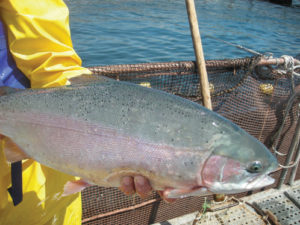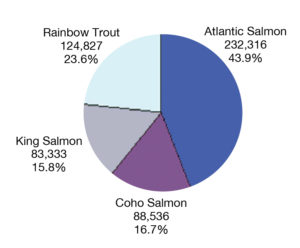Country leads global production, further growth possible

Chile has exceptional natural conditions – including numerous fjords with appropriate temperatures in its southern region – for the culture of rainbow trout (Oncorhynchus mykiss), especially in floating cages. These conditions and position itself prominently in international markets. Production in 2007 reached around 175,000 metric tons (MT), representing 29 percent of global production (Table 1), and globally Chile has become the top producer of rainbow trout (Table 2).
Other factors that contributed to the industry’s growth include the relative ease of culture of trout compared to other salmonids produced in Chile, excellent local supplies of quality seed and qualified labor, and the availability of fishmeal, an important component in salmonid feeds. Ongoing improvements in management practices can effectively satisfy specific export markets.
Industry improvements, markets
In 2008, Chile’s trout industry required around 164 million eyed eggs, of which 74 percent were produced locally. Among other benefits, many of these locally produced eggs are resulting in increased fish yields, higher survival and growth rates, and monosex (all female) and sterile populations. This last achievement is the result of the implementation of various improvement programs by egg- and salmon-producing companies that began several years ago.
Colihueque, Chilean production and global production, table 1
| 2000 | 2001 | 2002 | 2003 | 2004 | 2005 | 2006 | 2007 | |
|---|---|---|---|---|---|---|---|---|
| Chile production | 79,666 | 109,985 | 111,681 | 109,578 | 122,252 | 118,279 | 151,119 | 175,139 |
| Global production | 447,384 | 511,506 | 509,237 | 505,017 | 509,299 | 500,488 | 542,727 | 604,695 |
| Portion of global production | 17.8% | 21.5% | 21.9% | 21.7% | 24% | 23.6% | 27.8% | 29% |
Colihueque, Main rainbow trout- producing countries, Table 2
| Country | 2007 Production (mt) |
|---|---|
| Chile | 175,139 |
| Norway | 77,578 |
| Iran | 58,761 |
| Italy | 37,800 |
| France | 32,288 |
| Denmark | 27,657 |
| Spain | 25,195 |
| United States | 23,682 |
| Germany | 23,174 |
| Poland | 16,650 |
| Other | 106,771 |
Another important achievement is improved management in both the fresh- and seawater production phases. Market-size fish that deliver excellent yields in the processing plants are ready to harvest after 11 to 13 months in the Seawater phase.

Total trout exports in 2008 reached 124,000 MT, which represented 23.4 percent of Chile’s total salmonid exports (Fig. 1) and revenues of $594 million. Japan and the United States are the most important export markets for Chilean rainbow trout.
In the Japanese market, trout are mostly marketed whole. Therefore, a silvery appearance similar to that of coho salmon, with clear belly and skin with few dark spots, is highly valued in Japan. In contrast, in the U.S. and other markets, Chilean trout are sold in various presentations, including fresh and frozen fillets, smoked, pan-size fish and others.
Chilean trout farmers have developed production strategies to specifically satisfy these markets. For example, for the Japanese market, Chilean farmers target 2.8- to 3-kg fish similar in size to the coho salmon with which Japanese consumers are familiar.
Potential for expansion
In recent years, global demand for rainbow trout has increased. This demand, together with the stability in trout production costs, good market prices and increasing profitability from value-added products, has supported the interest of Chilean producers to remain in the trout-farming industry.
The Chilean industry is expected to continue consolidating in the coming years. In addition, many local producers believe their products will maintain local market share based on the estimated 40 percent 2009 reduction in Atlantic salmon production due to the current outbreak of viral Infectious salmon anemia (ISA).
The devastating consequences of this crisis have favored trout farmers because rainbow trout do not develop ISA’s clinical signs, although they can be vectors for its transmission. In fact, some believe that rainbow trout could replace Atlantic salmon exports to some markets like the United States, while others caution that over-production of trout could negatively affect prices and create problems for export markets like Japan. Nevertheless, it must be kept in mind that Atlantic salmon generate higher profits than rainbow trout to Chilean producers, and their production levels will come back once the current crisis is resolved.
Perspectives
Trout farming in Chile still has room to grow, especially considering that its production efficiency in seawater is below that of other salmon-culturing countries like Norway. Trout farming can become a key component for improved sustainability of the overall salmonid industry in Chile, especially once additional biosecurity measures are fully implemented. These include the new sanitary management areas that came into effect in June 2009 in response to the ISA virus outbreak.
In addition, once the current global financial crisis passes, Chile’s trout farming will likely see additional expansion due to increased demand for established and new products in traditional markets like the U.S., Japan and Europe, as well as new markets in Asia, particularly in China.
(Editor’s Note: This article was originally published in the January/February 2010 print edition of the Global Aquaculture Advocate.)
Authors
-
Nelson Colihueque, M.S.
Departamento de Ciencias Básicas
Universidad de Los Lagos
P. O. Box 933
Osorno, Chile[108,99,46,115,111,103,97,108,117,64,104,105,108,111,99,110]
-
Francisco Estay, M.S.
Piscícola Huililco Ltda.
Centro Ojos del Caburgua
Pucón, Chile
Tagged With
Related Posts

Intelligence
A land grab for salmon (and shrimp) in upstate New York
The operators of Hudson Valley Fish Farm see their inland locale as a pilot to prove that land-based fish farming, located in close proximity to major metropolitan markets, can be successful.

Intelligence
A motive, and a market, for farmed fish in Mexico
Boasting ample areas for aquaculture and a robust domestic demand for seafood – not to mention its close proximity to the U.S. market – a land of opportunity lies in Mexico. Fish farming is primed to meet its potential south of the border.

Innovation & Investment
AquaGen CEO: Genomics are transforming aquaculture
The CEO of AquaGen knew that the Norwegian research group’s work in genomics was key to the salmon industry’s future. And that was before she even worked there.

Innovation & Investment
Aquaculture Exchange: David Little, University of Stirling
David Little, professor at the University of Stirling in Scotland, tells the Advocate about the rapid evolution of the aquaculture industry in Southeast Asia — where he made his home for many years — and discusses the role of academia in ushering in new eras of innovation.


